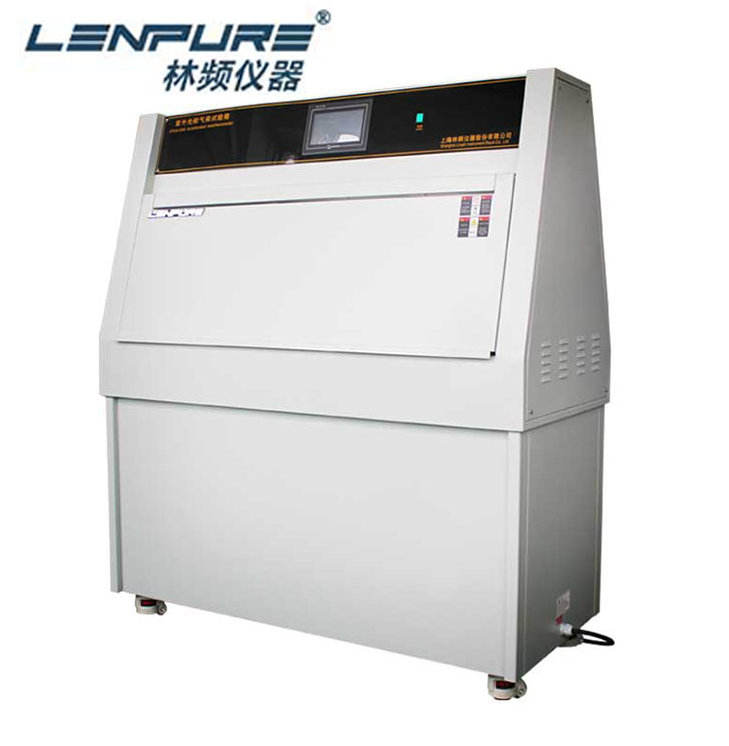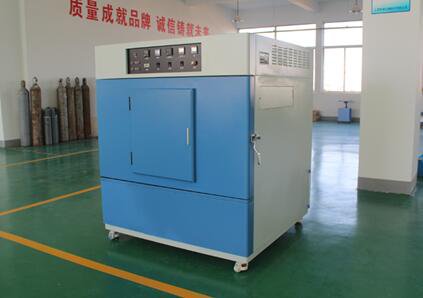Environmental Test Chambers for ASTM D882 Standard Test Method for Tensile Properties of Thin Plastic Sheeting
Lenpure UV-Lamp Weathering Test Chambers take fluorescent UV lamp as light source to simulate the UV irradiation in natural light and condensation to conduct accelerated weathering test to the materials. It can simulate the UV, rain, high temperature, high humidity, condensate, darkness and other environmental conditions in natural climate and combine them in a circle, and carry out these circles automatically.

Today, we continue to talk about the standard SATM D882 of UV test chamber. This method covers the determination of tensile properties of plastics in the form of thin sheeting and films (less than 1.0 mm (0.04 in.) in thickness).
This test method can be used to test all plastics within the thickness range described and the capacity of the machine employed. Specimen extension can be measured by grip separation, extension indicators, or displacement of gage marks.
The procedure for determining the tensile modulus of elasticity is included at one strain rate.Test data obtained by this test method is relevant and appropriate for use in engineering design. The values stated in SI units are to be regarded as the standard. The values in parentheses are provided for information only.
This standard does not purport to address all of the safery concerns, if any, associated with its use. It is the responsibility of the user of this standard to establish appropriate safety, health, and environmental practices and deterlicability of regulatory limitations prior to use.
Summary of Test Method
A specimen of uniform cross-section is loaded in tension via means of a mechanical testing machine. Force and or extension are recorded during the test.
Various techniques for pecimen gripping and extension measurement are addressed. Depending on the elongation of the material and the desired properties to be gained from the testing, various combinations of grip separation and test speed are utilized. Properties such as tensile stress, elongation and modulus can be calculated.
Tensile properties determined by this test method are of value for the identification and characterization of materials for control and specification purposes. Tensile properties can vary with specimen thickness, method of preparation, speed of testing, type of grips used, and manner of measuring extension.
Consequently, where precise comparative results are desired these factors must be carefully controlled. This test method shall be used for referee purposes, unless otherwise indicated in particular material specifications.
For many materials, there can be a specification that requires the use of this test method but with some procedural modifications that take precedence when adhering to the specification. Therefore, it is advisable to refer to that material specification before using this test method. Table 1 in Classification D4000 lists the ASTM materials standards that currently exist.
Testing Machine-A testing machine of the constant rate-of-crosshead-movement type and comprising essentially the following:
Fixed Member-A fixed or essentially stationary member carrying one grip.
Movable Member-A movable member carrying a second grip.
Grips-A set of grips for holding the test specimen between the fixed member and the movable member of the testing machine; grips can be either the fixed or self-aligning type. In either case, the gripping system must minimize both slippage and uneven stress distribution.
Extensometer (Optional)-A suitable instrument used for determining the distance between two designated points on the test specimen as the specimen is stretched. The use of this type of instrument is optional and is not required in this test method.
This apparatus, if employed, shall be so designed as to minimize stress on the specimen at the contact points of the specimen and the instrument, It is desirable that this instrument automatically record the distance, or any change in it.
As a function of the force on the test specimen or of the lapsed time from the start of the test, or both. If only the latter is obtained, force-time data must also be taken. This instrument must be essentially free of inertial lag at the specified speed of testing. Thickness Gauge-A dead-weight dial or digital micrometer as described in Test Methods D5947 or D6988 as appropriate for the material or specimen geometry being tested.
Width-Measuring Devices-Suitable test scales or other width measuring devices capable of measuring 0.25 mm (0.010 in.) or less.
Specimen Cutter-Refer to Practice D6287 for the apparatus and techniques for cutting film and sheeting used in this test method.
The test specimens shall consist of strips of uniform width and thickness at least 50 mm (2 in.) longer than the grip separation used.
The nominal width of the specimens shall be not less than 5.0 mm (0.20 in.) or greater than 25.4 mm (1.0 in.).
A width-thickness ratio of at least eight shall be used Narrow specimens magnify effects of edge strains or flaws, or both.
The utmost care shall be exercised in cutting specimens to prevent nicks and tears that cause premature failures. The edges shall be parallel to within 5 % of the width over the length of the specimen between the grips.
Test specimens shall be selected so that thickness is uniform to within 10% of the average thickness over the length of the specimen between the grips in the case of specimens 0.25 mm (0.010 in) or less in thickness and to within 5 % in the case of specimens greater than 0.25 mm (0.010 in.) in thickness but less than 1.00 mm (0.040 in.) in thickness.
If the material is suspected of being anisotropic, two sets of test specimens shall be prepared having their long axes respectively parallel with and normal to the suspected direction of anisotropy.
For tensile modulus of elasticity determinations, a specimen gage length of 250 mm (10 in.) shall be considered as standard. This length is used in order to minimize the effects.of grip slippage on test results.
When this length is not feasible.test sections as short as 100 mm (4 in.) can be used if it has been shown that results are not appreciably affected. However, the 250-mm (10-in.) gage length shall be used for referee purposes.
The speed of testing of shorter specimens must be adjusted in order for the strain rate to be equivalent to that of the standard specimen.
Conditioning
Conditioning-Condition the test specimens at 23t 20C (73.4 ± 3.69F) and 50±10% relative humidity for not less than 40 h prior to test in accordance with Procedure A of Practice D618 unless otherwise specified by agreement or the relevant ASTM material specification. In cases of disagreement, the tolerances shall be t1C (+1.89F) and ±5 % relative humidity.
Test Conditions-Conduct the tests at 23 ±20℃ (73.4+ 3.69F) and 50 ± 10% relative humidity unless otherwise specified by agreement or the relevant ASTM material specification. In cases of disagreement, the tolerances shall be ±1C.(±1.8F) and ±5 % relative humidity.
This type of UV aging climate chambers are also available for customized.

If you are still interested in any kind of environmental test chambers, and I'm pleased provide some of our details and project to you. That's more, at present we have more attractive price for you. Welcome for inquiry any time, I will reply asap!
If you want to know more information about climate chambers or our company, please feel free to contact sales@lenpure.com or visit http://www.lenpure.com/ .











